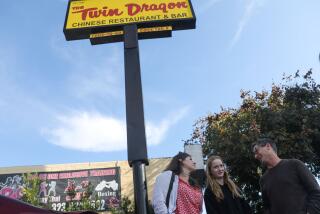Special Shopping Trips Mark Approach of Sukkot
- Share via
Ari Scharf had made four trips to the little trailer on Beverly Boulevard in two days, but the perfect etrog still eluded him.
With only two days left before the beginning of Sukkot, the Jewish holiday of the tabernacles that begins tonight, Scharf and other men shopping Monday night at the Yeshiva Lulav and Etrog Center painstakingly examined the etrogim--citrus fruits that look like large, bumpy lemons. All were searching for shapely, fragrant, blemish-free specimens to carry to temple as symbols of purity and balance.
For the record:
12:00 a.m. Oct. 16, 1997 For the Record
Los Angeles Times Thursday October 16, 1997 Home Edition Metro Part B Page 3 Metro Desk 1 inches; 27 words Type of Material: Correction
Sukkot preparations--In Wednesday’s Times, a photo caption accompanying a story on the Jewish holiday of Sukkot was in error in identifying Rabbi Dov Osina. Osina was not shown in the photo.
“I’m going to come back tomorrow morning,” said a frustrated Scharf at 9 p.m., three hours before the etrog vendor’s closing time.
The 21-year-old had also done some shopping at home in Brooklyn before traveling to Los Angeles to celebrate Sukkot with his family, but was still empty-handed.
The fruits, which generally sell for between $35 and $200 in Los Angeles, are individually wrapped in flax and imported from Israel. Their cultivation is carefully monitored, with etrog farmers constructing boxes around each fruit while it is still on the branch to protect it from anything that might leave marks on its skin.
The harvested etrogim are shipped in boxes sealed with a sticker certifying their pure pedigree: These fruits were not grown from etrog branches grafted onto lemon trees; they are the genuine article.
The etrog, also called a citron, is the most important of four ceremonial items used by Jewish families observing Sukkot, said Rabbi Yitzchok Adlerstein, director of the Jewish Studies Institute of Yeshiva of Los Angeles.
During the eight-day holiday, most Orthodox Jews assemble an outdoor shelter called a sukkah to eat and sleep in to commemorate the 40 years that Jews wandered in the desert after the Exodus from Egypt more than 3,000 years ago.
In addition to building a sukkah, families also collect an etrog, a palm branch (in Hebrew, lulav), and a stalk each of myrtle (hadas) and willow leaves (aravah). They are brought to the synagogue all week, and a blessing is said over them in the family sukkah. Waving the items north, south, east, west, up and down symbolizes God’s omnipresence on Earth, Adlerstein said.
One interpretation of the ritual holds that the four items represent different types of people.
The fragrant, flavorful citron is “your basic Oscar-winner,” Adlerstein said, the one who has it all. The palm branch has stature and nobility, he said, the myrtle a beautiful aroma, and the willow is in effect the wallflower of the quartet, with neither scent nor taste.
Another explanation says that the etrog is the heart, the palm the spine, and the shape of the myrtle and willow leaves correspond to eyes and lips.
“The idea is that when you bring them all together, suddenly everybody has a place, everybody capitalizes on the strength of others,” Adlerstein said. “Even the aravah, the loser, when brought together with the others starts to develop a place for itself.”
But before all the elements can come together, one must pay a visit--sometimes a long one--to one of Los Angeles’ handful of seasonal etrog dealers.
Rabbi Dov Osina, 41, says he imported 2,500 etrogim this year, and he will probably sell almost all of them before tonight. About 10 days ago, he set up his trailer in the parking lot of a mini-mall where he owns a kosher restaurant and cafe.
Last Sunday alone he had 300 customers. Most are in and out within an hour, Osina said, but some agonize for much longer and then ask his permission to take an etrog to their rabbi for approval.
Osina said some customers wait until the last minute and may have to pay dearly for it.
At 9:30 p.m. Monday, Ari Scharf decided to forgo additional hemming and hawing and bought seven of the fruit for $250.
So, with just under two days to spare, Scharf finally had his etrogim.
More to Read
Sign up for The Wild
We’ll help you find the best places to hike, bike and run, as well as the perfect silent spots for meditation and yoga.
You may occasionally receive promotional content from the Los Angeles Times.






